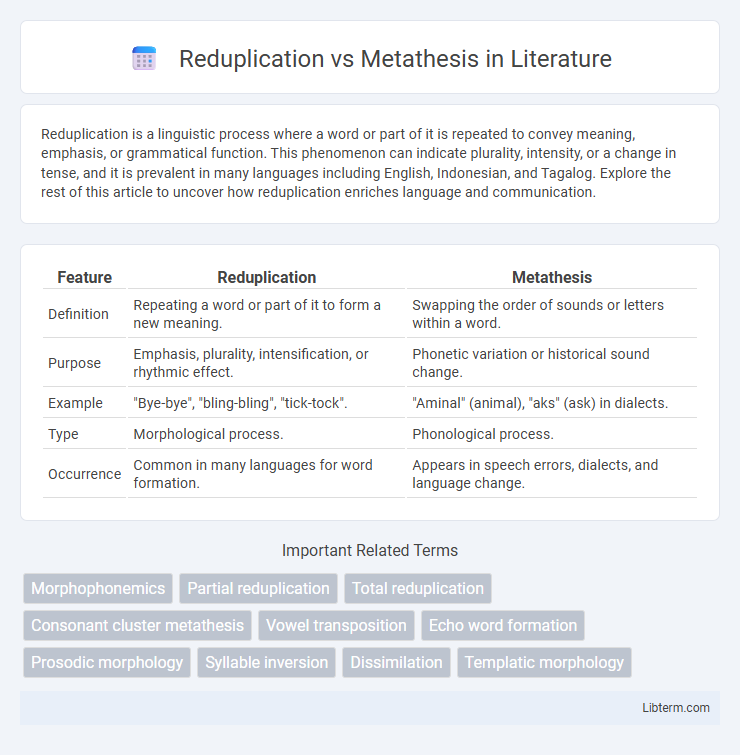Reduplication is a linguistic process where a word or part of it is repeated to convey meaning, emphasis, or grammatical function. This phenomenon can indicate plurality, intensity, or a change in tense, and it is prevalent in many languages including English, Indonesian, and Tagalog. Explore the rest of this article to uncover how reduplication enriches language and communication.
Table of Comparison
| Feature | Reduplication | Metathesis |
|---|---|---|
| Definition | Repeating a word or part of it to form a new meaning. | Swapping the order of sounds or letters within a word. |
| Purpose | Emphasis, plurality, intensification, or rhythmic effect. | Phonetic variation or historical sound change. |
| Example | "Bye-bye", "bling-bling", "tick-tock". | "Aminal" (animal), "aks" (ask) in dialects. |
| Type | Morphological process. | Phonological process. |
| Occurrence | Common in many languages for word formation. | Appears in speech errors, dialects, and language change. |
Introduction to Reduplication and Metathesis
Reduplication is a morphological process where a word or part of it is repeated to convey grammatical or semantic meaning, such as indicating plurality or intensity. Metathesis involves the rearrangement of sounds or syllables within a word, often occurring as a phonological phenomenon or historical language change. Both processes illustrate different mechanisms of linguistic modification impacting word structure and meaning.
Defining Reduplication: Meaning and Types
Reduplication is a linguistic process involving the repetition of a word or part of a word to convey grammatical or semantic meaning, such as plurality, intensity, or repetition. Common types include full reduplication, where the entire word is repeated (e.g., "bye-bye"), and partial reduplication, where only a segment repeats (e.g., "zig-zag"). This morphological phenomenon contrasts with metathesis, which deals with the reordering of sounds within a word rather than repetition.
Understanding Metathesis: Concept and Examples
Metathesis is a phonological phenomenon where two adjacent sounds or letters swap places within a word, altering its pronunciation or sometimes its meaning. Common examples include the transformation of Old English "brid" into Modern English "bird" and the Greek example "askrion" becoming "askion." Understanding metathesis aids linguists in tracing language evolution and phonetic shifts across dialects and time periods.
Linguistic Functions of Reduplication
Reduplication serves linguistic functions such as intensification, plurality, and grammatical aspect marking, distinguishing it from metathesis, which involves phoneme reordering without semantic expansion. In languages like Indonesian and Tagalog, reduplication creates new lexical meanings or denotes repeated actions, thereby enriching morphology and syntax. Unlike metathesis, which primarily affects phonological structure, reduplication plays a crucial role in conveying semantic nuances and grammatical relationships.
Phonological Aspects of Metathesis
Metathesis involves the transposition of sounds or syllables within a word, altering its phonological structure and affecting segment order without changing meaning. This phonological process contrasts with reduplication, which duplicates whole or partial phonological units to form new words or grammatical markers. Metathesis often emerges from speech errors or language evolution, exemplified in cases like the Old English "brid" becoming Modern English "bird," reflecting shifts in phonotactic constraints and articulation patterns.
Reduplication Across World Languages
Reduplication is a widespread morphological process found across world languages, involving the repetition of a whole or part of a word to express grammatical functions such as plurality, intensity, or tense. It contrasts with metathesis, which involves the rearrangement of sounds within a word rather than repetition. In languages like Indonesian, Tagalog, and many African languages, reduplication serves crucial roles in verb conjugation, noun formation, and semantic modulation, highlighting its typological significance in linguistic structure.
Metathesis in Historical Linguistics
Metathesis in Historical Linguistics refers to the phenomenon where sounds within a word switch places, often influencing phonological evolution and dialectal variation over time. Unlike reduplication, which involves the repetition of a whole or part of a word to create morphological forms, metathesis primarily affects the order of phonemes, as seen in examples like Old English "brid" changing to Modern English "bird." This process provides crucial insights into language change mechanisms and helps trace the development of phonetic shifts across related languages and language families.
Similarities Between Reduplication and Metathesis
Reduplication and metathesis both involve morphological changes that affect the form of words to convey meaning or grammatical function. Both processes manipulate internal structure: reduplication duplicates a segment or whole word part to modify aspect or intensity, while metathesis rearranges the order of sounds within a word to alter pronunciation or meaning. These phonological phenomena highlight language's flexibility in shaping word forms through systematic sound patterns.
Key Differences: Reduplication vs Metathesis
Reduplication involves the repetition of a whole or part of a word to convey grammatical or semantic changes, such as plurality or intensification, while metathesis is the transposition of sounds or syllables within a word, affecting its phonetic structure. Reduplication often serves morphological functions like forming plurals or verb aspects, whereas metathesis typically results from historical language change or speech errors without creating new words. Key differences between reduplication and metathesis include their linguistic purposes, mechanisms, and outcomes in word formation and pronunciation.
Conclusion: Linguistic Significance and Insights
Reduplication and metathesis reveal distinct mechanisms of phonological and morphological change that enrich linguistic diversity and structure. Reduplication, involving repetition of sounds or syllables, often serves grammatical or semantic functions like plurality or intensity, while metathesis involves the rearrangement of sounds within a word, affecting pronunciation and sometimes meaning. Studying these processes offers valuable insights into language evolution, cognitive processing, and phonetic variation across languages.
Reduplication Infographic

 libterm.com
libterm.com